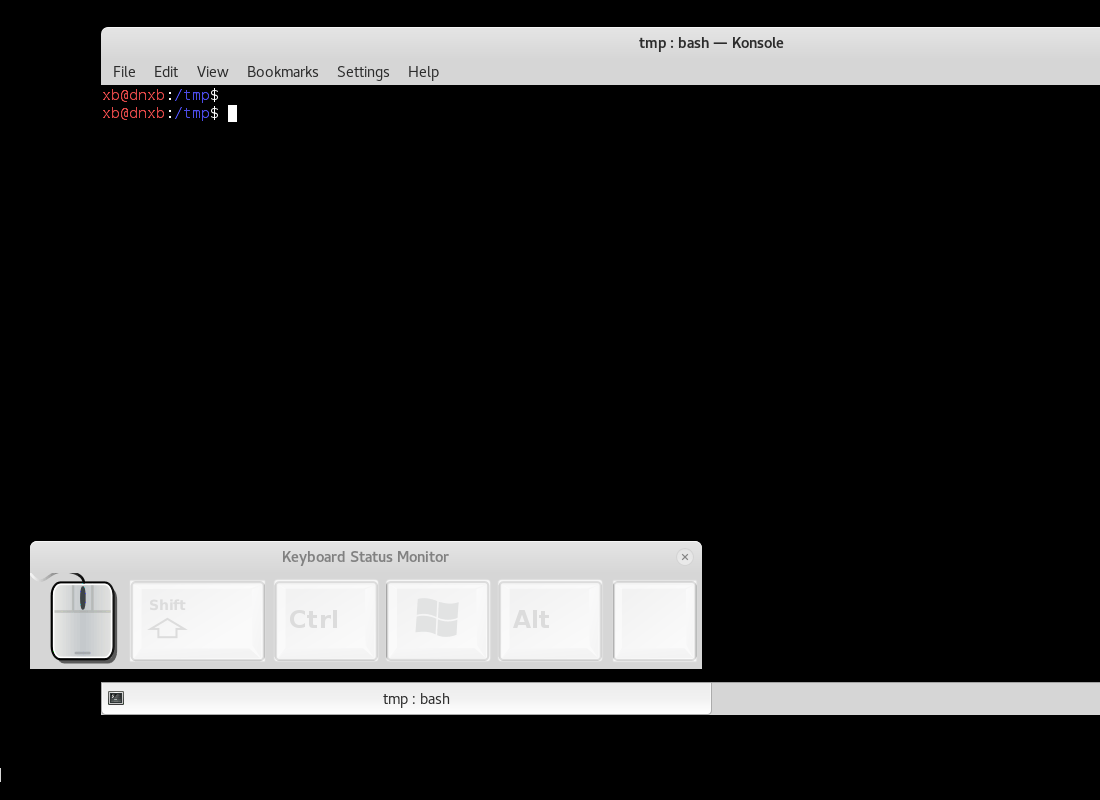我只是用C编写的:
#include <stdio.h>
#include <curses.h>
#include <time.h> //time(0)
#include <sys/time.h> // gettimeofday()
#include <stdlib.h>
void waitFor (unsigned int secs) {
//credit: http://stackoverflow.com/a/3930477/1074998
unsigned int retTime = time(0) + secs; // Get finishing time.
while (time(0) < retTime); // Loop until it arrives.
}
int
main(void) {
struct timeval t0, t1, t2, t3;
double elapsedTime;
clock_t elapsed_t = 0;
int c = 0x35;
initscr();
cbreak();
noecho();
keypad(stdscr, TRUE);
halfdelay(5); //increae the number if not working //adjust below `if (elapsedTime <= 0.n)` if this changed
printf("\nSTART again\n");
elapsed_t = 0;
gettimeofday(&t0, NULL);
float diff;
int first = 1;
int atleast_one = 0;
while( getch() == c) { //while repeating same char, else(ffff ffff in my system) break
int atleast_one = 1;
if (first == 1) {
gettimeofday(&t1, NULL);
first = 0;
}
//printf("DEBUG 1 %x!\n", c);
gettimeofday(&t2, NULL);
elapsedTime = (t2.tv_sec - t1.tv_sec) + ((t2.tv_usec - t1.tv_usec)/1000000.0);
if (elapsedTime > 1) { //hit max time
printf("Hit Max, quit now. %f\n", elapsedTime);
system("gnome-terminal");
//waitFor(4);
int cdd;
while ((cdd = getch()) != '\n' && cdd != EOF);
endwin();
exit(0);
}
if(halfdelay(1) == ERR) { //increae the number if not working
//printf("DEBUG 2\n");
//waitFor(4);
break;
}
else {
//printf("DEBUG 3\n");
}
}
if (atleast_one == 0) {
//gettimeofday(&t1, NULL);
t1 = t0;
}
gettimeofday(&t3, NULL);
elapsedTime = (t3.tv_sec - t1.tv_sec) + ((t3.tv_usec - t1.tv_usec)/1000000.0);
printf("Normal quit %f\n", elapsedTime);
if (elapsedTime > 0.6) { //this number based on halfdelay above
system("gedit &");
//system("xdotool key shift+left &");
//system("mplayer -vo caca -quiet 'video.mp4' &");
//waitFor(4);
}
else if (elapsedTime <= 0.6) {
system("xdotool key ctrl+shift+t &");
//waitFor(4);
}
int cdd;
while ( (cdd = getch() ) != '\n' && cdd != EOF);
endwin();
return 0;
}
使用showkey -a获得的绑定键码:
xb@dnxb:/tmp$ sudo showkey -a
Press any keys - Ctrl-D will terminate this program
^[[24~ 27 0033 0x1b #pressed F12
91 0133 0x5b
50 0062 0x32
52 0064 0x34
126 0176 0x7e
5 53 0065 0x35 #pressed Numpad 5, 5 is the keycode used in `bind`
^C 3 0003 0x03
^D 4 0004 0x04
xb@dnxb:/tmp$
将绑定键码5及其命令(例如run /tmp/.a.out)放入〜/ .bashrc中:
bind '"5":"/tmp/a.out\n"'
请注意,相关的键码也需要在源代码中进行更改(十六进制值也可以从sudo showkey -a上面获取):
int c = 0x35;
编译(/tmp/a.out在我的示例中为输出):
cc filename.c -lcurses
示范:
数字键5,短按打开新选项卡,中按打开gedit,长按打开gnome-terminal。

这不是直接适用于gnome桌面管理器的任何窗口,但我认为它应该使您知道如何(很难)实现它。它也可以在虚拟控制台(Ctrl + Alt + N)中运行,并且可以在某些终端仿真器(例如konsole,gnome-terminal,xterm)中运行。
p / s:我不是交流程序员,所以如果这段代码没有经过优化,请原谅我。
[更新]
前面的答案仅在shell中有效并且需要关注,因此我认为解析/ dev / input / eventX是在整个X会话中工作的解决方案。
我不想重新发明轮子。我试用evtest实用程序,并用自己的代码修改了evtest.c的底部:
int onHold = 0;
struct timeval t0;
double elapsedTime;
int hitMax = 0;
while (1) {
rd = read(fd, ev, sizeof(struct input_event) * 64);
if (rd < (int) sizeof(struct input_event)) {
perror("\nevtest: error reading");
return 1;
}
system("echo 'running' >/tmp/l_is_running 2>/tmp/l_isrunning_E &");
for (i = 0; i < rd / sizeof(struct input_event); i++) {
//system("date >/tmp/l_date 2>/tmp/l_dateE &");
if (ev[i].type == EV_KEY) {
if ( (ev[i].code == 76) ) {
if (!onHold) {
onHold = 1;
t0 = ev[i].time;
hitMax = 0;
}
if (!hitMax) { //to avoid hitMax still do the time checking instruction, you can remove hitMax checking if you think it's overkill, but still hitMax itself is necessary to avoid every (max) 2 seconds will repeatly system();
elapsedTime = (ev[i].time.tv_sec - t0.tv_sec) + ((ev[i].time.tv_usec - t0.tv_usec)/1000000.0);
printf("elapsedTime: %f\n", elapsedTime);
if (elapsedTime > 2) {
hitMax = 1;
printf("perform max time action\n");
system("su - xiaobai -c 'export DISPLAY=:0; gedit &'");
}
}
if (ev[i].value == 0) {
printf("reseted ...... %d\n", ev[i].value);
onHold = 0;
if (!hitMax) {
if (elapsedTime > 1) { //just ensure lower than max 2 seconds
system("su - xiaobai -c 'export DISPLAY=:0; gnome-terminal &'");
} else if (elapsedTime > 0.5) {
system("su - xiaobai -c \"export DISPLAY=:0; vlc '/home/xiaobai/Downloads/videos/test/Pokémon Red_Blue_Yellow Gym Leader Battle Theme Remix-CbJTkx7QUJU.mp4' &\"");
} else if (elapsedTime > 0.2) {
system("su - xiaobai -c 'export DISPLAY=:0; nautilus &'");
}
} else { //else's max system() already perform
hitMax = 0;
}
}
}
}
}
}
请注意,您应该更改用户名(xiaobai是我的用户名)部分。另外,这if ( (ev[i].code == 76) ) {也是我的Numpad 5键码,您可能需要手动打印ev [i] .code进行两次确认。当然,您也应该更改视频路径:)
直接编译并对其进行测试(``部分是为了获得正确的/dev/input/eventN):
$ gcc /home/put_your_path/my_long_press.c -o /home/put_your_path/my_long_press; sudo /home/put_your_path/my_long_press `ls -la /dev/input/by-path/* | grep kbd | echo "/dev/input/""$(awk -F'/' '{print $NF}')" ` &
请注意,/by-id/这在Fedora 24中不起作用,因此我将其更改为/ by-path /。卡利没有这样的问题。
我的桌面管理器是gdm3:
$ cat /etc/X11/default-display-manager
/usr/sbin/gdm3
所以,我/etc/gdm3/PostLogin/Default在gdm启动时以root身份运行此命令以运行此命令(/etc/X11/Xsession.d/*不起作用):
/home/put_your_path/my_long_press `ls -la /dev/input/by-id/* | grep kbd | echo "/dev/input/""$(awk -F'/' '{print $NF}')" 2>/tmp/l_gdm` 2>/tmp/l_gdmE &
出于未知原因/ etc/gdm/PostLogin/Default在Fedora 24'gdm上不起作用,这在检查日志时给我“ 权限被拒绝 ” /tmp/l_gdmE。手动运行没问题。
示范:
数字键5,即时按下(<= 0.2秒)将被忽略,短按(0.2到0.5秒)打开nautilus,中按(0.5到1秒)打开vlc播放视频,长按(1-2秒)打开gnome-terminal,然后按超时(2秒)打开gedit。

我在这里上传了完整的代码(只有一个文件)。
[再次更新]
[1]添加了多个键流,并notify-send通过define 修复了失败DBUS_SESSION_BUS_ADDRESS。[2]已添加XDG_CURRENT_DESKTOP并GNOME_DESKTOP_SESSION_ID确保konsole使用gnome主题gui(如果不使用gnome,请更改它)。
我在这里更新了代码。
请注意,此代码不适用于组合键流程,例如Ctrl+ t。
更新:
有多个设备接口,/ dev / input / by-path / XXX-eventN条目序列是随机的。因此,我将命令更改/etc/gdm3/PostLogin/Default如下(Chesen是我的键盘名称,对于您的情况,应将其更改为grep Razer):
/your_path/my_long_press "$(cat /proc/bus/input/devices | grep -i Chesen -A 4 | grep -P '^(?=.*sysrq)(?=.*leds)' | tr ' ' '\n' | ls /dev/input/`grep event`)" 2>/tmp/l_gdmE &
您可以尝试从中提取eventN摘录cat /proc/bus/input/devices | grep -i Razer -A 4:
$ cat /proc/bus/input/devices | grep -i Razer -A 4
N: Name="Razer Razer Naga Chroma"
P: Phys=usb-0000:00:14.0-1.3/input0
S: Sysfs=/devices/pci0000:00/0000:00:14.0/usb3/3-1/3-1.3/3-1.3:1.0/0003:1532:0053.0003/input/input6
U: Uniq=
H: Handlers=mouse2 event5
--
N: Name="Razer Razer Naga Chroma"
P: Phys=usb-0000:00:14.0-1.3/input1
S: Sysfs=/devices/pci0000:00/0000:00:14.0/usb3/3-1/3-1.3/3-1.3:1.1/0003:1532:0053.0004/input/input7
U: Uniq=
H: Handlers=sysrq kbd event6
--
N: Name="Razer Razer Naga Chroma"
P: Phys=usb-0000:00:14.0-1.3/input2
S: Sysfs=/devices/pci0000:00/0000:00:14.0/usb3/3-1/3-1.3/3-1.3:1.2/0003:1532:0053.0005/input/input8
U: Uniq=
H: Handlers=sysrq kbd leds event7
$
在上面的示例中,sudo cat /dev/input/event7单击Razer鼠标上的12位数字grep -P '^(?=.*sysrq)(?=.*leds)'(上面使用的模式为“ sysrq kbd leds event7”)时,仅会输出奇异的输出(您的模式可能会有所不同)。sudo cat /dev/input/event6仅当单击中间的上/下键时,才会打印出奇怪的输出。sudo cat /dev/input/event5当移动鼠标并滚动滚轮时,While 将输出奇异的输出。
[更新:支持重新插入键盘电缆以重新加载程序]
以下是不言自明的:
$ lsusb #to know my keyboard is idVendor 0a81 and idProduct 0101
...
Bus 001 Device 003: ID 0a81:0101 Chesen Electronics Corp. Keyboard
$ cat /etc/udev/rules.d/52-hole-keyboard.rules #add this line with your idVendor and idProduct above in custom udev rules file
ACTION=="add", SUBSYSTEM=="usb", ATTR{idVendor}=="0a81", ATTR{idProduct}=="0101", MODE="0666", GROUP="plugdev", RUN+="/bin/bash -c 'echo 1 > /tmp/chesen_plugged'"
$ cat /usr/local/bin/inotifyChesenPlugged #A long run listener script to listen for modification of /tmp/chesen_plugged #Ensures `inotifywait` has been installed first.
touch /tmp/chesen_plugged
while inotifywait -q -e modify /tmp/chesen_plugged >/dev/null; do
killall -9 my_long_press
/usr/local/bin/startLongPress &
done
$ cat /usr/local/bin/startLongPress #the executable script run the long press executable #Change with your pattern as explained above.
#!/bin/bash
<YOUR_DIR>/my_long_press "$(cat /proc/bus/input/devices | grep -i Chesen -A 4 | grep -P '^(?=.*sysrq)(?=.*leds)' | tr ' ' '\n' | ls /dev/input/`grep event`)" 2>/tmp/l_gdmE) & disown
$ cat /etc/gdm3/PostLogin/Default #the executable startup script run listener and long press script
/usr/local/bin/inotifyChesenPlugged &
/usr/local/bin/startLongPress &

